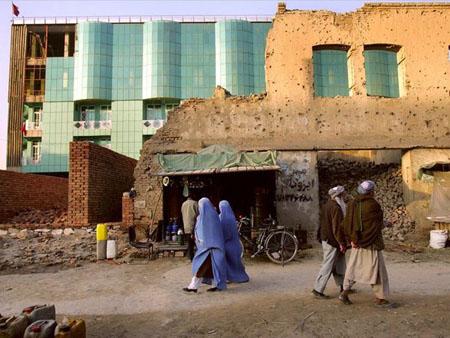Examiner.com, August 1, 2011
Tale of Two Kabuls
Afghanistan was rated as the second most corrupt country in 2010 by Transparency International, and the trend is getting worse
By Michael Hughes

Examiner.com, Aug. 1, 2011: Officials in the Ministry of Urban Development and Kabul Municipality say up to 70 percent of new high-rise buildings in the capital are illegal and built without regard to local laws or regulations by powerful individuals known as the "land mafia". (Photo: Getty Images)
Afghanistan’s capital city has experienced a financial and development boom over the past decade, growing in population from 1.5 to 5 million people while gleaming new malls and apartment complexes have sprung up and dot the landscape. But these bastions of the rich are offset by the sharp contrast of crowded shanty towns and squatter settlements where dwell the other Kabul - the downtrodden and oppressed living in squalor, representing an inequality gap that is grossly widening by the day.
The billions pumped into Afghanistan accounting for its double-digit growth have been consolidated into the hands of a few - the societal and political elite. Meanwhile, the rest of the Afghans suffer from unemployment that still hovers around 40%. 36% of the population still lives below the poverty line with over 5 million people trying to survive on $43 a month.
Sayed Masoud, an economics lecturer at Kabul University said the foreign aid-inspired GDP growth has been "hijacked by oligarchs".
"Social unrest, violence and rebellion against the state are the most likely outcomes in a society where a majority of people live in extreme poverty but small elite groups thrive in affluence," said Masoud, adding that social justice was a prerequisite for peace-making in war-torn Afghanistan.
Officials in the Ministry of Urban Development and Kabul Municipality say up to 70 percent of new high-rise buildings in the capital are illegal and built without regard to local laws or regulations by powerful individuals known as the "land mafia".
According to a 2010 UN report: "Unprecedented resource flows have created a new cast of rich and powerful individuals who operate outside the traditional power/tribal structures and bid the cost of favors and loyalty to levels not compatible with the under-developed nature of the country."
Afghanistan was rated as the second most corrupt country in 2010 by Transparency International, and the trend is getting worse.
The growth that has been attained is a product of a war-time economy driven by external largesse, resulting in another two Kabuls – the one we see today and the one that will exist when foreign forces and their foreign money leave.
A Senate Foreign Relations Committee report recently released indicated that “an estimated 97 percent of Afghanistan’s GDP is derived from spending related to the international military and donor community presence.”
Although a January 2011 report issued by the Special Inspector General for Afghan Reconstruction (SIGAR) boasted of 20% growth rates, the biggest growth area in Afghanistan’s economy was in “services" - as in services provided to the U.S. military and international community.
The Afghanistan Analysts Network’s Thomas Ruttig told a correspondent from The Age that the money that has flown into Kabul since 2001 has created an economic bubble and a false sense of security.
Rutting said an Afghan friend told him recently: “The day the West stops paying for the Afghan army and the Afghan police, the next day there is no Afghan army or Afghan police anymore.”
Manufacturing barely exists, and efforts to create a mining sector from the land's mineral wealth have failed. Although the Afghans are reportedly sitting on nearly $3 trillion worth of unexplored uranium, lithium, copper and iron ore – not a single red cent has been produced to date.
Experts from Integrity Watch Afghanistan say the resources won’t be extracted for years, even decades, because of infrastructure and security challenges. And down the road warlords could spark additional violence in a bid to profit from the country's minerals. Not unlike the convoy protection rackets that have allowed plenty of strongmen to swim in millions.
Sadly, the only sustainable revenue source comes from a black market industry. ''The biggest part of the economy that is left is drugs … somewhere around 11 per cent of the Afghan population is involved in the drug economy,” Ruttig said.
The country has not been able to develop a peacetime economy in over 30 years due to incessant war. And when U.S.-led coalition forces leave in 2014, these conditions are unlikely to change until the underlying culture of corruption bred by a predatory government is eradicated.
Government powerbrokers and their respective militias will be left to fend for themselves against a growing Taliban insurgency. And unless a broad, inclusive political settlement is put in place that empowers the rest of civil society through an equitable redistribution of wealth and opportunity, the formula is set for countless years of civil war.
Characters Count: 6246
